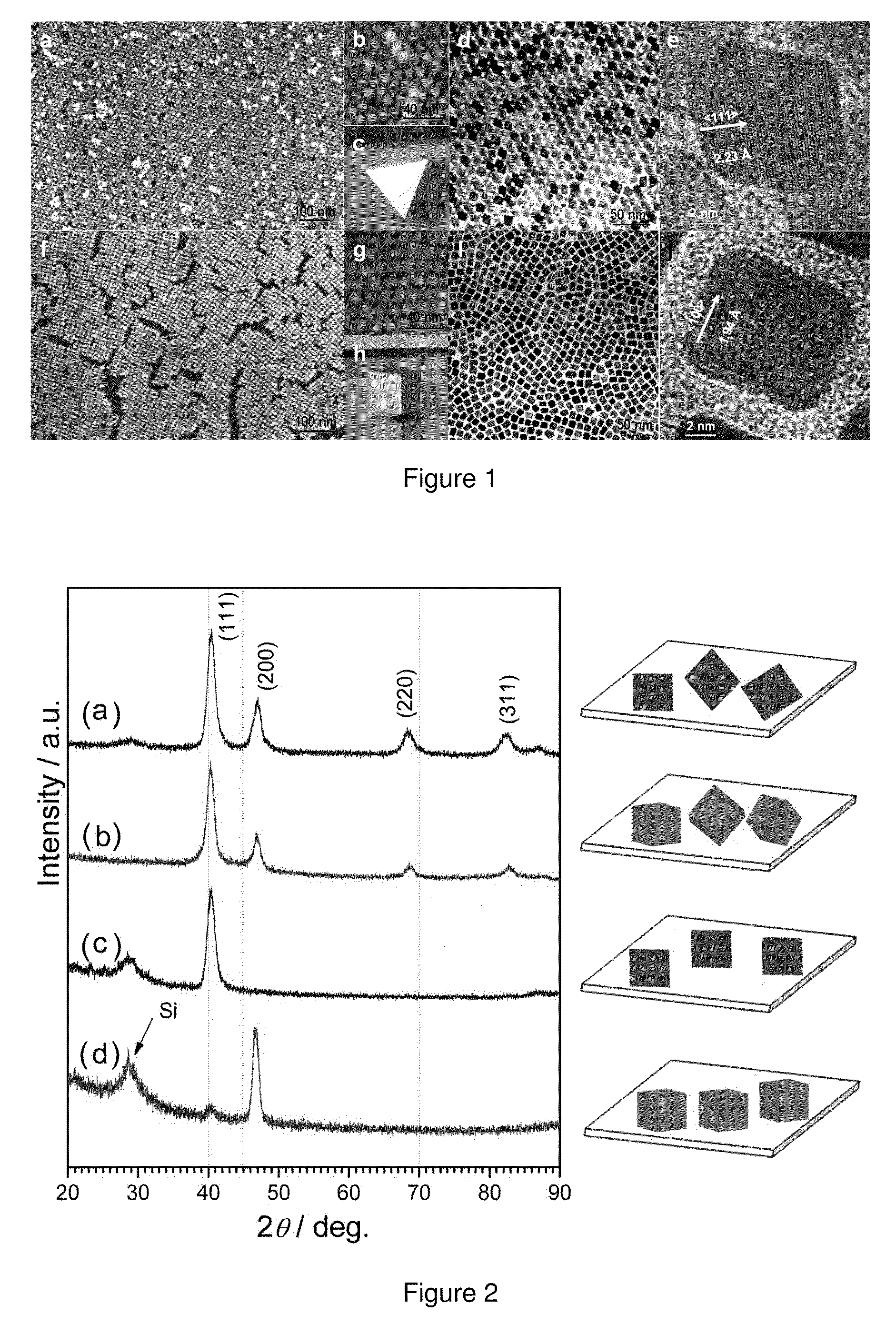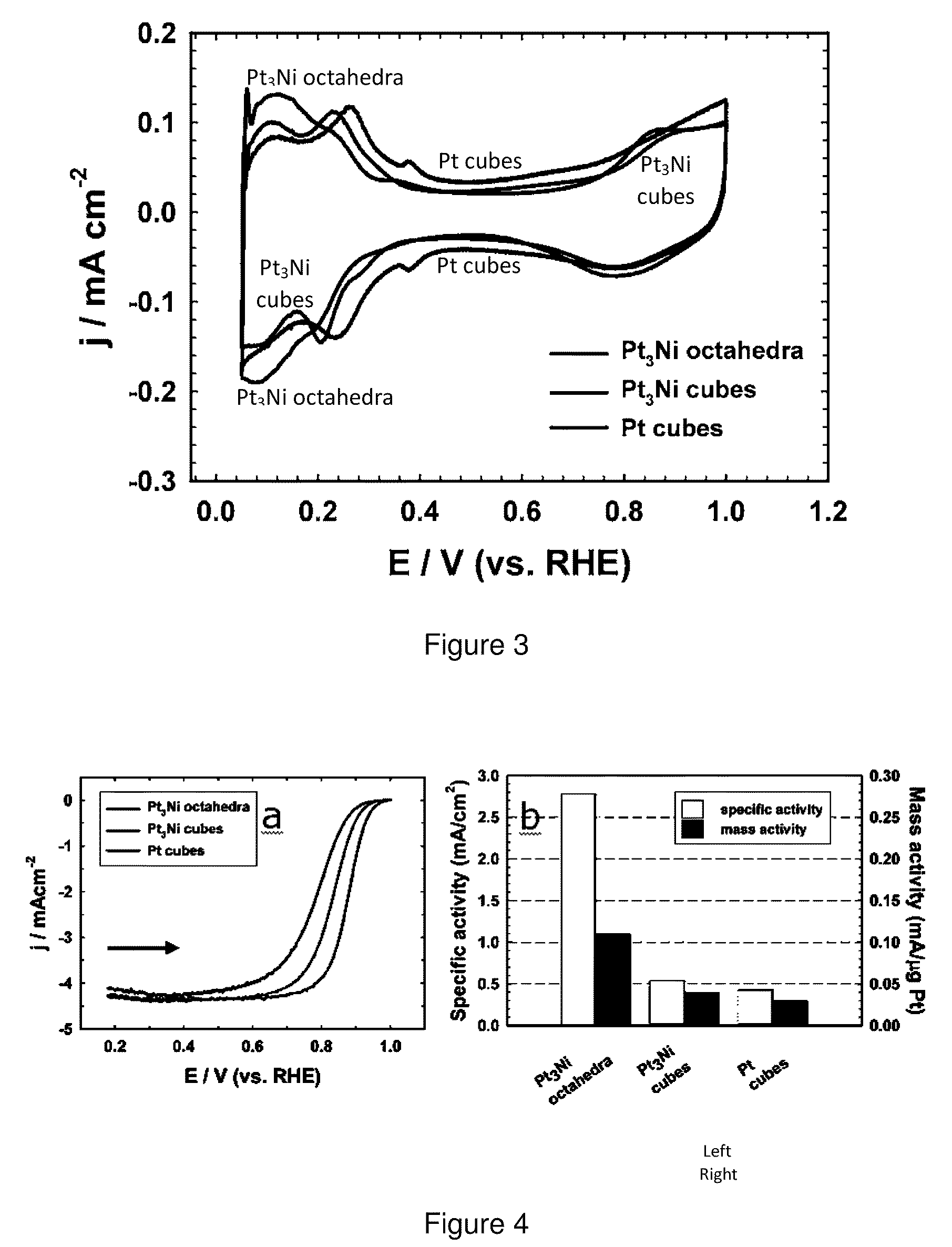CATALYTIC PLATINUM AND ITS 3d-TRANSITION-METAL ALLOY NANOPARTICLES
a technology of catalyst platinum and alloy nanoparticles, which is applied in the direction of metal/metal-oxide/metal-hydroxide catalysts, physical/chemical process catalysts, cell components, etc., to achieve the effect of increasing the activity of nanoctagedra, reducing size, and increasing electrocatalytic activity
- Summary
- Abstract
- Description
- Claims
- Application Information
AI Technical Summary
Benefits of technology
Problems solved by technology
Method used
Image
Examples
example 1
[0055]Synthesis of Pt3Ni nanoctahedra and nanocubes. A typical procedure for synthesizing Pt3Ni nanoctahedra is as follows: under airless conditions, platinum (II) acetylacetonate (20 mg, 0.05 mmol), nickel (II) acetylacetonate (10 mg, 0.04 mmol), oleylamine (9.0 mL) and oleic acid (1.0 mL) were loaded into a three-neck flask and heated to 130° C. under an argon stream. Tungsten hexacarbonyl (50 mg, 0.14 mmol) was then added into the vigorously stirred solution, and the temperature was subsequently raised to 230° C. and maintained for 40 min with vigorous agitation. The resultant products were isolated by centrifugation after adding a sufficient amount of absolute ethanol, and washed with anhydrous hexane for several cycles. The Pt3Ni nanooctahedra were finally re-dispersed in hexane, forming a colloidal suspension. The yield was estimated as high as ˜80% on the basis of Pt.
[0056]To synthesize Pt3Ni nanocubes, platinum (II) acetylacetonate (20 mg, 0.05 mmol), oleylamine (9.0 mL) and...
example 2
Synthesis Details
[0132]Synthesis of Pt NCbs. 0.020 g of platinum (II) acetylacetonate, 8.0 mL of oleylamine and 2.0 mL of oleic acid were loaded into a three-neck flask equipped with a condenser and attached to a Schlenk line. The mixture was heated to 130° C. with vigorous stirring under an argon stream. 0.05 g of tungsten hexacarbonyl was then added into the solution and the temperature was subsequently raised to 240° C. and kept for 30-60 min with a vigorous agitation. The resultant products were isolated by centrifugation and washed with anhydrous hexane for several cycles, followed by a size-selection treatment. The Pt NCbs were finally re-dispersed in hexane, forming a colloidal suspension.
[0133]Synthesis of Pt3Co NCbs. 0.0125 g of cobalt acetate tetrahydrate, 0.020 g of platinum (II) acetylacetonate, 8.0 mL of oleylamine and 2.0 mL of oleic acid were loaded into a three-neck flask equipped with a condenser and attached to a Schlenk line. The mixture was heated to 130° C. with...
PUM
| Property | Measurement | Unit |
|---|---|---|
| Electric charge | aaaaa | aaaaa |
| Electric charge | aaaaa | aaaaa |
| Temperature | aaaaa | aaaaa |
Abstract
Description
Claims
Application Information
 Login to View More
Login to View More - R&D
- Intellectual Property
- Life Sciences
- Materials
- Tech Scout
- Unparalleled Data Quality
- Higher Quality Content
- 60% Fewer Hallucinations
Browse by: Latest US Patents, China's latest patents, Technical Efficacy Thesaurus, Application Domain, Technology Topic, Popular Technical Reports.
© 2025 PatSnap. All rights reserved.Legal|Privacy policy|Modern Slavery Act Transparency Statement|Sitemap|About US| Contact US: help@patsnap.com



